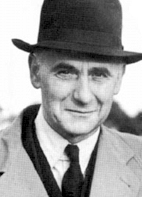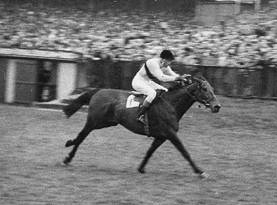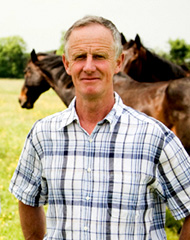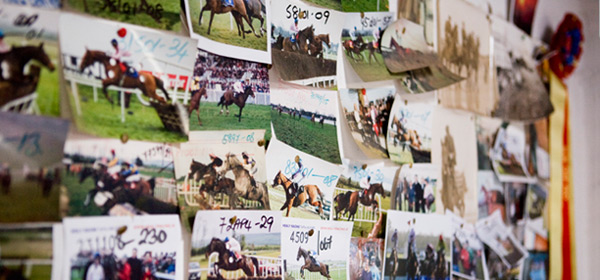History
Greenogue’s partnership with racing began in 1931 when Tom Dreaper took out a public licence for the first time and began training a small string of horses. With no formal training in working racehorses, Tom called upon his instinct and judgment to develop his own system, the same intuition and care is evident in Jim Dreaper who has continued his father’s legacy with the same tendency towards perfection and excellence. These routines and systems still guide the day to day working of the yard but have evolved with the sport to incorporate the new approaches and directions that have been introduced over the years.
Tom Dreaper
 Tom’s career featured many of racing's most memorable events to date. In the 1920s and ‘30s he was among the leading amateur, point-to-point and hunter chase riders in the country, although the '40s, '50s and ‘60s are the years that will be remembered forever. Supported by his wife, Betty, during these three decades he trained 26 winners at the Cheltenham festival, including the Cheltenham Gold Cup and the Arkle Challenge Trophy Chase five times each and the Queen Mother Two-Miles Champion Chase a still unbeaten six times.
Tom’s career featured many of racing's most memorable events to date. In the 1920s and ‘30s he was among the leading amateur, point-to-point and hunter chase riders in the country, although the '40s, '50s and ‘60s are the years that will be remembered forever. Supported by his wife, Betty, during these three decades he trained 26 winners at the Cheltenham festival, including the Cheltenham Gold Cup and the Arkle Challenge Trophy Chase five times each and the Queen Mother Two-Miles Champion Chase a still unbeaten six times.
He trained seven consecutive Irish Grand National winners (1960–1966), to round of his total of a record ten wins. He also trained the winner of the Leopardstown Handicap Chase seven years in a row (1962–1968) and two of his horses, Arkle and Flying Bolt, still retain the highest Timeform ratings, 212 and 210 respectively. He was not so much aided by truly great horses as he had an eye for great, true horses. Just a few of the most successful horses to come out of Greenogue during Tom’s career were Prince Regent, Arkle, Flying Bolt, Ben Stack and Fortria.
Prince Regent was a typical Dreaper horse, big and good looking. He won five of his seven races in the 1941/42 season, including the Irish Grand National, carrying 12st 7lbs. He appeared for the first time in England in 1945 when he won The Bradford Chase. He won the Cheltenham Gold Cup as an 11-year-old in March of that year, carried 12st 5lbs to finish third in the Grand National at Aintree and was fourth with 12st 7lbs the following year.
 Arkle is a horse that needs little introduction. One of the first true stars of the sport, his fame spread far beyond the racing world. The three year old Arkle was bought by the Duchess of Westminster in 1960. He first ran in 1962, winning the Honeybourne Chase at Cheltenham. He had an overwhelming record of 27 wins from 35 starts, at times carrying over two stones more than his rivals (the Irish racing authorities devised two weight systems, one for when Arkle was running and another when he wasn’t), under Pat Taaffe.
Arkle is a horse that needs little introduction. One of the first true stars of the sport, his fame spread far beyond the racing world. The three year old Arkle was bought by the Duchess of Westminster in 1960. He first ran in 1962, winning the Honeybourne Chase at Cheltenham. He had an overwhelming record of 27 wins from 35 starts, at times carrying over two stones more than his rivals (the Irish racing authorities devised two weight systems, one for when Arkle was running and another when he wasn’t), under Pat Taaffe.
Arkle's wins included the Cheltenham Gold Cup (three times), the Sun Alliance Chase, the King George Chase, the Irish Grand National, the Hennessy Cognac Gold Cup, the Punchestown Gold Cup and the Powers Gold Cup. Generally known as 'Himself', he was hugely popular, and his clashes with Mill House in the mid-1960s were the most anticipated sporting events of the time.
Flying Bolt was described as “racing’s great unsung hero”. He was one of the few horses that was considered an eligible rival to Arkle. He was a versatile horse, having the speed to take on 2 miles and the stamina for more. Pat Taaffe was his regular jockey also and among his many wins are the Gloucesterhire Hurdle in 1964, the 1965 Cotswold Chase (now the Arkle Challenge Trophy Chase), the Black & White Gold Cup in 1965, the Massey Ferguson Gold Cup at Cheltenham in 1965 and the Queen Mother Champion Chase in 1966.
Fortria was bred in 1942 and began racing at the age of five. He won 14 National Hunt races between then and 1961 when he won the Irish Grand National. He won the Queen Mother Chase in 1960 and 1961, both times under Pat Taaffe. He was the first ever winner of the Paddy Power Gold Cup, then called the Mackeson Gold Cup, in 1960 and again in 1962.
Ben Stack was also owned by the Duchess of Westminster and was considered one of the best looking horses to come out of Greenogue. He went on to win the 1963 Cotswold Chase (now the Arkle Challenge Trophy Chase) and Queen Mother Handicap Chase in 1964.
Jim Dreaper
 Jim Dreaper took out his training licence at the age of 20 and got straight to work, clocking up his first win just two months into his career in the Schweppes Gold Trophy with Good Review. He rode Black Secret to second place in the Aintree Grand National, losing by a neck the race that has so far eluded the Greenogue stable.
Jim Dreaper took out his training licence at the age of 20 and got straight to work, clocking up his first win just two months into his career in the Schweppes Gold Trophy with Good Review. He rode Black Secret to second place in the Aintree Grand National, losing by a neck the race that has so far eluded the Greenogue stable.
He was champion jumps trainer in Ireland in each of his first five seasons and, in 1974, he trained Colebridge to win the Irish Grand National, winning with Brown Lad the following two years and again in 1978. He also trained the winners of the Cheltenham Gold Cup, Queen Mother Champion Chase and World Hurdle in 1975 with Ten Up, Lough Inagh and Brown Lad respectively.
Jim has an enviable list of wins to his name, having also won the Welsh Grand National, the Sun Alliance Chase, the Hennessy Cognac Gold Cup, the Martell Cup Chase, the Dr P. J. Moriarty Novice Chase, the Power Gold Cup numerous times each, not to mention countless others. Some of the most renowned horses, past and present, have been Ten Up, Brown Lad, Carvill’s Hill, Merry Gale, Harcon and Notre Pere.
Ten Up took home the 1974 Sun Alliance Novices' Chase and the Cheltenham Gold Cup.
Brown Lad won the 1974 Sun Alliance Hurdle at Cheltenham, the Reynoldstown Chase at Ascot and the Lloyds Bank Hurdle in Cheltenham in 1975. He became the only horse to win three Irish Grand Nationals, 1975, 1976 and again in 1978.
The 1980s saw the arrival of the hugely talented Carvill’s Hill. While he was a troubled horse, he won the 1989 Hennessy Cognac Gold Cup, the John Durkan Memorial Chase under Ken Morgan and the 1989 Vincent O´Brien Irish Gold Cup Chase among others.
Then came the very popular Harcon who won his opening races and took the Dr P. J. Moriarty Novice Chase at Leopardstown in 1995, I.A.W.S Novice Chase, Winelectric Novice Chase and a second Sun Alliance Chase 1995.
In the same period, Merry Gale was in training at Greenogue and out of his 18 wins were the 1994 Dr P. J. Moriarty Novice Chase, 1995 MMI Stockbrokers Punchestown Chase, the 1995 Martell Cup Chase, the 1996 McCain Handicap Chase, the Heineken Gold Cup, the Power Gold Cup, the Durken Punchestown Chase in 1994 and 1995 and the 1999 Paddy Power Dial-A-Bet Chase.
Currently in training is Notre Pere who has already established his name in the history books as the first ever Irish trained horse to win the Welsh Grand National. Other wins to his name are the Williamhill.ie Troytown Handicap Chase, the Punchestown Guinness Gold Cup and the Knight Frank Ganly Walters Novice Chase.

